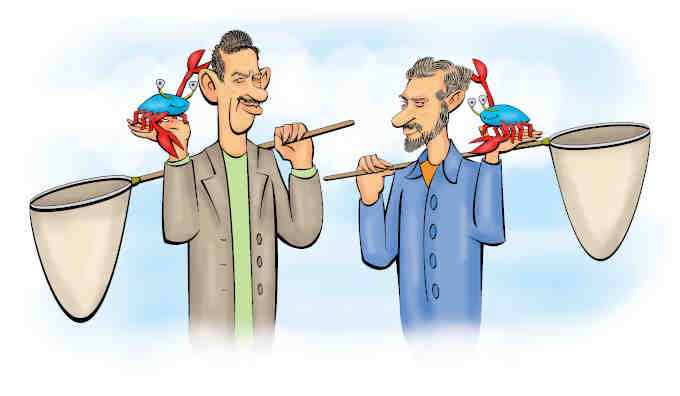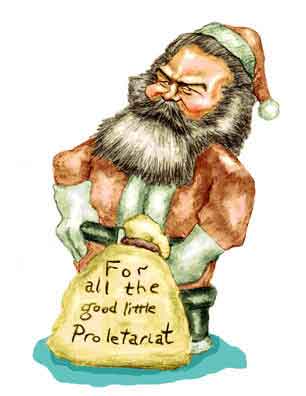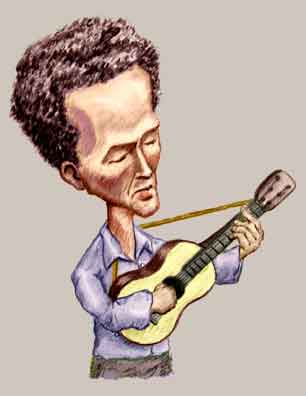John Steinbeck and Ed Ricketts
(And Friends)

John Steinbeck and Ed Ricketts |
"With reasonably well-balanced and non-neurotic Lightfoots we stood no chance."
|
At some point you can bet that the - quote - "great novels" - unquote - of days gone by will become the trite and hackneyed drudgeries assigned to middle school kids. Why, today you'll even find critics trashing the books that once served the purpose of television: Oliver Twist, Treasure Island, Pride and Prejudice, The Sun Also Rises. More recently lists of "boring" books have been including - at one time unthinkable - The Lord of the Rings and the Narnia series.
And of course, there's John Steinbeck's #1 best seller, The Grapes of Wrath. Once hailed as one of the greatest books of the 20th century, today's critics can be pretty ruthless. The book is boring, they say. The characters are one-dimensional. The dialog is hokey.
But what's worse, even the history is wrong! The Joads were from Sallisaw, for crying out loud! That's in the Cookson Hills where the Ozarks spill across from Arkansas into Oklahoma. Sallisaw is only 20 miles from Fort Smith, for heaven's sake! There's trees there!
But ... but ... what about the Great Dust Storm described at the beginning of the book? And also of the devastated farms where nothing grows? There's pictures. You can't deny that there was a "Dust Bowl".
But not in Eastern Oklahoma, mes amis (as they'd say in Sequoyah County). Sure, there were poor farmers there. But if you read the history of the area you'll find that a goodly number the farmers managed to weather the 1930's farms intact and quite well, thank you. Just ask the farming family of long time resident Charles Arthur Floyd.

Charles Arthur Floyd
Long-Time Resident.
If you did want to see the Dust Bowl you had to go to the Western Plains, pretty much past the 100th Meridian. Those pictures of the giant dust clouds rolling in were taken in the Texas and Oklahoma panhandles. Similarly, the iconic picture of the farmer running toward the house with his kids as the dust covers his fields and home was in Cimarron County, the western-most part of Oklahoma which lies just east of New Mexico, south of Colorado, and north of Texas. That's over 400 miles west of Sallisaw!

Someone named Karl.
And the novel is a perfect example of how you can tell the truth but not the whole truth. Yes, there were families who left Oklahoma for California and ended up in migrant camps where conditions were harsh and squalid. But many of the "Okies" got to California and found work, not just on the farms but in the cities - and thanks to good old American Free Enterprise. There they stayed and their grand children became the Baby Boomers with their children forming the subsequent multi-named Generations that continue to the present.
So say what you like, the critics snort. The Grapes of Wrath is bad writing and bad history. In the end the message is nothing more than a thinly disguised hagiography of the bankrupt philosophy of someone named Karl.
Hold on there! say John's fans. Because some people weathered the Dust Bowl doesn't mean it didn't affect the lives of millions. And there were hundreds of thousands from Texas to North Dakota whose families were completely displaced.
And it's a novel, for Pete's sake! A work of fiction doesn't have to be a sociological treatise on how every single population division fared throughout the world. Writers have to compress action and consolidate events. And if someone wants to read a political statement into John's book, well, they're free to do so. But for every Trotskyite Leftist who toots his horn with the Grapes of Wrath, there's a Keysnian-Smith Free Enterpriser who can also use it to their effect.
Well, you can keep up this back and forth brouhaha forever. But the point is that what has happened with The Grapes of Wrath is what happens with every "classic" books if you wait long enough. As the gap between the The Grapes's publication and the present moves toward a century, changes have occurred not only in lifestyles and society's issues, but even in the way people speak and the way writers write. So the books get transformed - as we may quote from a work by another author - from a "first rate sociological document" with immediate relevancy to "a period piece" which is - if we might cite the dictionary - "something such as a book or a movie that is very old-fashioned, often in a way that is funny to people now". So eventually you'll find pretty much any novel relegated to the lists of "Most Overrated Books".

Woody squeezed it in.
Also we have to admit it, The Grapes of Wrath is pretty long for action that Woody Guthrie managed to squeeze into a seven minute song. A quicker read is another of John's top novels. That's Of Mice and Men about two migrant workers hoping to eventually find a life of peace and tranquility. Naturally, their best laid plans gang aglay. But that the book has high literary merit can't be denied since it's been satirized in Warner brother's cartoons.
Some say that John's writing declined after Grapes of Wrath and the last of his really good novels was East of Eden that was published in 1952. Oft times considered John's greatest - if lengthy - work, each day John also wrote a letter to his editor, Pascal Covici, before starting to write and these were collected in the quite readable book, Journal of a Novel: The East of Eden Letters. So you can see John's thinking as the novel developed. The book itself tells the story of two families of California's Salinas Valley and their familial backgrounds. The plot, to say the least, is complex.
Like much - quote - "great literature" - unquote - the books we've mentioned don't have particularly happy endings and there's lots of unpleasant characters. On the other hand, one of John's highly praised works is not a dour sad story. That's Cannery Row, a generally light-hearted book with a fairly optimistic ending. Its sequel, though, Sweet Thursday has plot elements that are a bit too far fetched to raise the book to the level of its predecessor.
The main character in Cannery Row and Sweet Thursday is Doc. Doc lives in Monterey, California, and runs the Western Biological Laboratories, a specimen supply house that sells preserved sea animals and prepared microscope slides to schools and universities. Doc is the local philosopher and advisor to all who "would listen to any kind of nonsense and change it for you to a kind of wisdom." Everybody liked him.
Doc was directly modeled on John's friend, Edward Flanders Ricketts. Ed owned and ran the Pacific Biological Laboratories in Monterey. Ed was born in Chicago in 1897 and so was John's senior by five years. He studied biology at the University of Chicago, and although he left without taking a degree, that was a time that only 50% of the population reached the 8th grade and when any college was considered higher education. Even professors at Oxford and Cambridge often had earned degrees no higher than a bachelors.1
Footnote
Neither Oxford and Cambridge professors John Ronald Reuel Tolkien and Clive Staples "Jack" Lewis had advanced degrees. Their Masters were honorary.
After Ed moved to Monterey and opened his lab, his collecting trips gave him first hand knowledge of the marine life along the California coast. He put his knowledge into print with Between Pacific Tides with writer Jack Calvin. Although there had been some difficulty in getting the book published, it was issued in 1939 by Stanford University Press and remains its #1 best seller.
Ed and John met around 1930 just after John had published Cup of Gold. Although the book got John started as an author, he didn't make a lot of money off it and with not much cash flow, he spent much of his leisure time talking with Ed.2
Footnote
Even after he began getting published John had to get by with odd jobs and handouts from friends and family. By 1935 John had four books published but he was by no means well off.
Then one day a chauffeur driven limousine pulled up to John's front door and out stepped a handsome gray haired and distinguished looking gentleman. It was Charlie Chaplin, looking nothing like his most famous character.
Charlie had discovered John's books and enjoyed them so much he would even drive around the region locating the areas described in the novels. One day he decided to meet the author of Cup of Gold, To a God Unknown, Tortilla Flat, and Of Mice and Men and just drove to John's house. Charlie's friendship brought John into contact with some of the rich and powerful of the entertainment world, and although you can say John was already on the path to fame and fortune, it certainly doesn't hurt to have the most famous man in the world as one of your biggest fans.
And as he became more successful, John began spending more time away from Monterey, and after he served in World War II as a war correspondent, he lived mostly on the East Coast. He rarely saw Ed, and when Ed's car was hit by a train in 1948, John didn't manage to get back to California until after Ed had died.
John, of course, went on to be one of the giants of American literature. The Grapes of Wrath won the Pulitzer Prize in 1940 and was quickly made into a movie that starred (and made a star of) Henry Fonda. He wrote fiction and non-fiction and even ventured into screenwriting. In 1962 John won the Nobel Prize in Literature.
Naturally a number of John's books and stories have been turned into movies. Of Mice and Men has been filmed three times (twice for the theaters and once for television) and has been performed as a play on Broadway. Some films have been successful - The Grapes of Wrath won three Oscars and turned a good profit - but Cannery Row in 1982 was a commercial and critical flop. Sometimes it's best to stick with the book.
That's certainly true for Cannery Row, and there are some - in a strictly logical sense - that rate another of John's nonfiction books as #1 (again in a logical sense). That's The Log from the Sea of Cortez. Originally published in 1941 as the narrative section of The Sea of Cortez, a book that was credited equally to John and Ed, its subtitle A Leisurely Journal of Travel and Research summarizes the book aptly. John and Ed had chartered a boat, The Western Flyer, for a six week trip (cost $2500) to collect specimens for Ed's biological business.
We have to say that like Huckleberry Finn said of Mark Twain, John told the truth, mainly. Yes, the general gist of the narrative follows their itinerary. But details - like their visit to a sad cantina where none of the other customers could afford to buy drinks and their trials and tribulations with the Hansen Sea Cow (the outboard motor of their landing boat) are, we must conclude, somewhat embellished.
Some critics feel that Ed should have been co-author of the Log even after it was issued as a separate book. Ed's own journal from the trip was later published (in a near-prohibitively expensive edition for which an interlibrary loan is a reasonable alternative) and one reviewer pointed out that a "close reading" shows that passages in the published narrative were from Ed's notes.
It is true that some parts of the Log were from Ed's original "Essay on Non-Teleological Thinking" which was not published until long after Ed's death. On the other hand, much of what Ed wrote of their trip was pretty matter-of-fact. For instance, he wrote the following about the crab known as Sally Lightfoots.
Uppermost rocks with Sally Lightfoots, but almost uncapturable, with white littorines.
[Crew member] Tiny [Colleto] caught 2 Sally Lightfoots.
Jon [sic] got one Sally Lightfoot, 2 solitary corals, some Plumularia hydroids.
But as published, the Log has parts written for humorous effect and are clearly of a very Steinbeckian style:
Many people have spoken at length of the Sally Lightfoots. These little crabs, with brilliant cloisonne carapaces, walk on their tiptoes. They have remarkable eyes and an extremely fast reaction time. If you hurry, they hurry. When you plunge at them, they seem to disappear in little puffs of blue smoke - at any rate, they disappear.
Then he writes of the strategy they employed - unsuccessfully - to catch a few specimens. But we won't spoil it for the reader.
References
The True Adventures of John Steinbeck, Writer, Jackson Benson, Viking Press, 1984.
"John Steinbeck", Susan Shillinglaw, American National Biography, 1999, 2000.
The Sea of Cortez: A Leisurely Journal of Travel and Research, With a Scientific Appendix Comprising Materials for a Source Book on the Marine Animals of the Panamic Faunal Province, John Steinbeck (author), Edward Ricketts (author), Viking, 1941.
The Log from the Sea of Cortez, John Steinbeck, Viking, 1951.
The Western Flyer: Steinbeck's Boat, the Sea of Cortez, and the Saga of Pacific Fisheries, Kevin M. Bailey, The University of Chicago Press, 2015.
Between Pacific Ties, Edward Ricketts and Jack Calvin, Stanford University Press, 1939, Revised Edition, 1948.
Breaking Through: Essays, Journals, and Travelogues of Edward F. Ricketts, Edward F. Ricketts Jr., University of California Press, 2006.
"A Whodunnit for the Literary Set: Why Was Ricketts Removed From Cortez Book?", Mark Shwartz, Stanford Report, December 3, 2003.
"John Steinbeck’s Epic Ocean Voyage Rewrote the Rules of Ecology", Richard Grant (author), Ian Bates (photographer), Smithsonian Magazine, September, 2019.
"Of Myths and Men in Monterey: 'Ed Heads' See Doc Ricketts as a Cult Figure", Eric Enno Tamm, SF Gate, October 16, 2005
Steinbeck: A Life in Letters, John Steinbeck (author), Elaine Steinbeck (editor), Robert Wallsten (editor), Viking Press, 1975.
"The Grapes of Wrath", Roger Ebert, RogerEbert.com, March 31, 2002.
"Why Celebrate ‘The Grapes of Wrath’?", Charlotte Allen, The Los Angeles Times, April 28, 2014.
"Doc of the Bay", Geoffrey Dunn, Books and Literature, MetroActive.
"Most Overrated Books Ever", Good Reads.
"That Little Bastard": John Steinbeck, Woody Guthrie, and a Modern American Cultural Revolution, Martha Jane Powers, Thesis, University of Colorado, 2014.
100 Story Project - Frank Wright: Knowing Ed Ricketts, M. D. Baer, Video, April 12, 2012.
100 Story Project - Herb Behrens: The Real Ed Ricketts, M. D. Baer, November 3, 2011.
"120 Years of American Education: A Statistical Portrait, Tom Snyder (editor), National Center for Education Statistics.
Cambridge Dictionary.